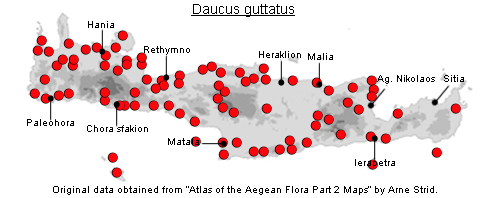
SPECIES DESCRIPTION
DAUCUS GUTTATUS
Family and Genus:- See- UMBELLIFERAE/Sect. DAUCUS
Common Names:- Daucus bicolor, Daucus setulosus
Homotypic Synonyms:- None
Meaning:- Daucus (L) Latin name for carrot.
Guttatus (Gr) Spotted, covered with small glandular dots.
General description:- Slender, erect or spreading annual
Stems:-
1) 20-60 cm, usually several, branched, erect or ascending, retrorse-scabrid or
sometimes hispid, near the base.
Leaves:-
1) Lower, 2-pinnate, segments divided into short, linear, acute lobes.
2) Upper, with linear segments.
3) Peduncles long, erect;
Flowers:-
1) Rays, 8-25.
2) Bracts, equalling or exceeding the flowers, pinnatifid, with segments, setaceous
or sometimes linear, entire.
a) bracteoles, setaceous.
3) Petals, 0·6-2·5 mm, white, those of the central umbel usually dark purple.
Fruit:-
1) 2-3 mm; spines of the secondary ridges 1-2 times as long as the width of the
mericarp.
Key features:-
1) Bracts, not deflexed in flower; usually longer than the the rays.
2) Spines, on the secondary ridges of the mericarp dilated but not markedly
confluent at the base.
Habitat:- Coastal habitats, dry pastures, dry open shrubby vegetation olive groves,
etc. 0-900(-1400) m.
Distribution:- Throughout Greece, but most common in the Aegean region. - C & E
Mediterranean area from S Italy and Cyrenaica to S Anatolia, Cyprus and Syria.
Fairly widespread across Crete.
Flowering time:- May-July.
Photos by:- Steve Lenton
